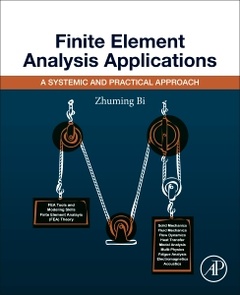Description
Finite Element Analysis Applications
A Systematic and Practical Approach
Author: Bi Zhuming
Language: English
Subjects for Finite Element Analysis Applications:
Keywords
Approximation; Benchmarking; Boundary conditions; Calculation validation; Classes and objects; Code verification; Computer aided engineering; Conduction; Conjugate heat transfer; Convection; Convergence study; Coordination systems (CS)Discretization; Decomposition; Delaunay triangulation; Design analysis and synthesis; Design engineers; Determinants; Direct methods; Eigenvalue problems; Eigenvalues; Engineering design processes; Engineering mathematics; Equilibrium problems; External loads; Fatigue analysis; Finite element analysis; Finite elements; Fluid flow; Fluid mechanics; Fluid�structure interaction (FSI)Multiphysics; Generic spring systems; Groundwater system; Heat transfer; Incompressible potential flows; Interpolation; Inverse matrix; Irrotational flow; Iso-parametric representation; Matrices; Meshing processes; Minimal potential energy; Nodes and elements; Object-oriented approach; Partial differential equations (PDEs)Transient problems; Pipe flow; Programming; Radiation; Reynolds Averaged Navier�Stokes(RANS)System coupling; Sensitivity study; Singularities; Software architecture; Static analysis; Steady systems; Structural design; Structural procedure; System architecture; System assembly; System complexity; System description; System of linear equations; System stability; Taylor expansion; Thermal-structural analysis; Thermodynamics; Transient heat transfer; Transient systems; Uncertainty quantification; Validation and verification (V&V)Vectors; Weighted residual methods
520 p. · 19x23.3 cm · Paperback
Description
/li>Contents
/li>Readership
/li>Biography
/li>Comment
/li>
Finite Element Analysis Applications: A Systematic and Practical Approach strikes a solid balance between more traditional FEA textbooks that focus primarily on theory, and the software specific guidebooks that help teach students and professionals how to use particular FEA software packages without providing the theoretical foundation. In this new textbook, Professor Bi condenses the introduction of theories and focuses mainly on essentials that students need to understand FEA models. The book is organized to be application-oriented, covering FEA modeling theory and skills directly associated with activities involved in design processes.
Discussion of classic FEA elements (such as truss, beam and frame) is limited. Via the use of several case studies, the book provides easy-to-follow guidance on modeling of different design problems. It uses SolidWorks simulation as the platform so that students do not need to waste time creating geometries for FEA modelling.
1. Overview of Finite Element Analysis Methods2. Decomposition3. Description of Elements4. Elemental Modelling5. System Analysis and Modelling6. Solutions to System Models7. Integrated Computer Design Environments8. Solid Mechanics Problems9. Heat Transfer Problem10. Flow Dynamics11. Multi-Physics Simulations12. Verification and Validation
3rd and 4th year students in mechanical, structural, civil, and aerospace engineering. Practicing engineers learning finite element methods
- Provides a systematic approach to dealing with the complexity of various engineering designs
- Includes sections on the design of machine elements to illustrate FEA applications
- Contains practical case studies presented as tutorials to facilitate learning of FEA methods
- Includes ancillary materials, such as a solutions manual for instructors, PPT lecture slides and downloadable CAD models for examples in SolidWorks




